7 Places to See Diego Rivera Murals in Mexico City
Are you wondering where to see Diego Rivera murals?
During my last trip to Mexico City, I discovered the vibrant capital is home to some of the most famous murals by Diego Rivera. They provide a fascinating view of Mexican history and culture while reflecting on its identity and social realities.
Many are easily accessible, located in public buildings in downtown Mexico City such as the murals at the National Palace and the Ministry of Education.
I found that the best way to see these famous Diego Rivera murals is to add them to your walking tour of the city center.
So that’s where I’ve started this guide, but I’ve also included a few lesser known places to see Diego Rivera murals that are worth checking out when you’re in the area.
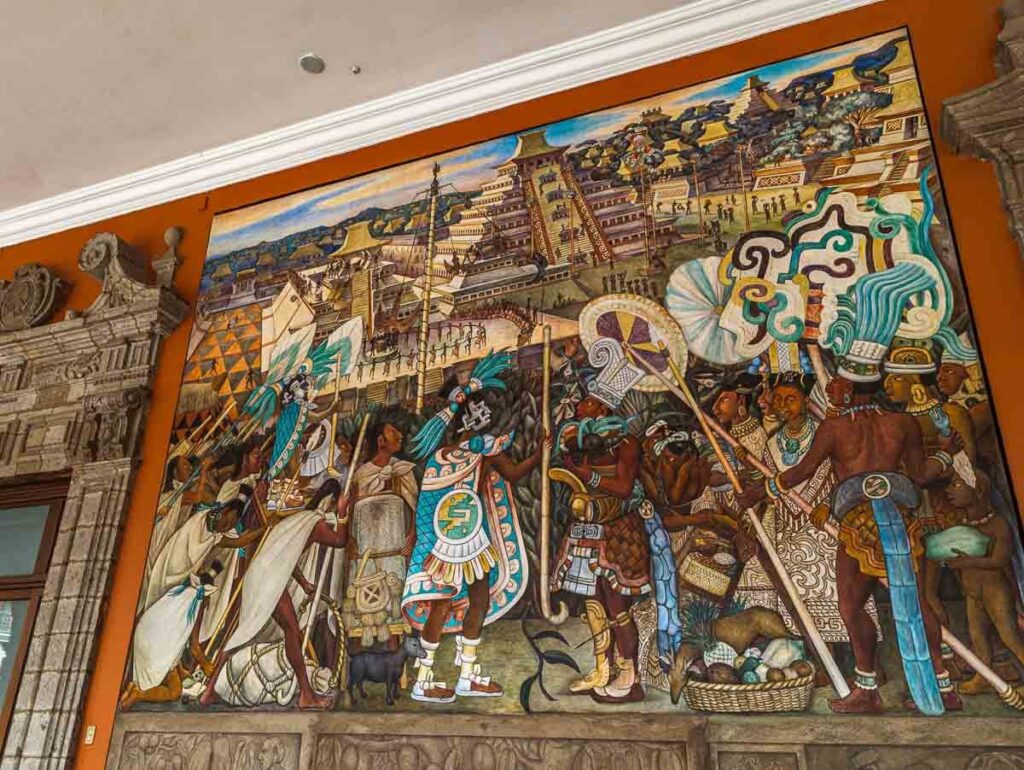
Quick History of Diego Rivera Mexico City Murals
Diego Rivera was a prominent figure in Mexican muralism, a public art movement that began in the 1920s. But Rivera’s murals were not merely decorative pieces. Many of his murals were political statements intended to provoke thought and inspire action.
Bold lines, flat forms, and vivid colors defined Rivera’s aesthetic. His compositions burst with movement and symbolism. While he humanized historical and revolutionary figures, working class people and indigenous cultures also dominated his scenes.

Throughout his murals in Mexico City, he crafted socially conscious statements through the depiction of Mexican culture and history while also shedding light on the injustices in society.
So let’s jump in to discover where you can see all of the Diego Rivera Mexico City murals.
1. National Palace Murals by Diego Rivera
📍 Centro Histórico (Map Location)
⌚ Tuesday – Sunday, 9:00 AM to 5:00 PM
💵 Free Entrance and Guided Tour
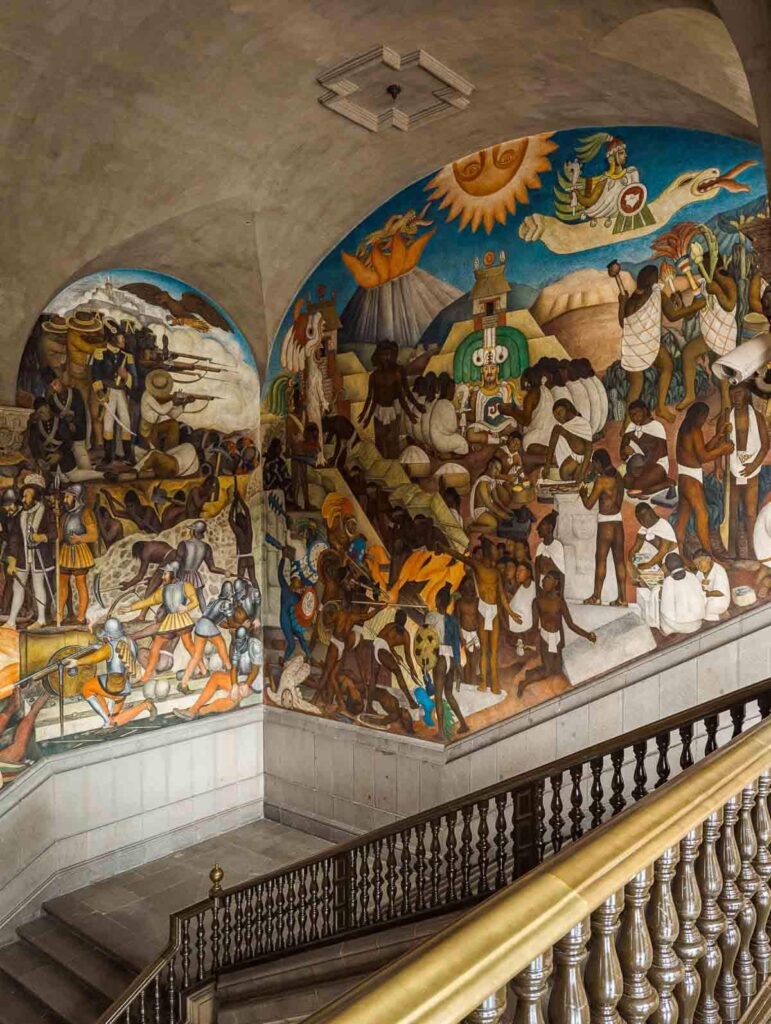
Located in the heart of downtown Mexico City, Palacio Nacional is not just the home of the Mexican President but one of the best places to see Diego Rivera murals.
During my visit, our guide explained that the government commissioned Diego Rivera to create these murals as a way of connecting with the people of Mexico, who were largely illiterate at the time.
I found the detail of the panoramic mural, The History of Mexico, to be mesmerizing. It depicts the history of Mexico from Mesoamerica through the Mexican Revolution.
Every figure and symbol seems as though it was carefully chosen to represent the complex interplay of cultures, ideologies, and people that have shaped Mexico.
How to See the Murals at the National Palace
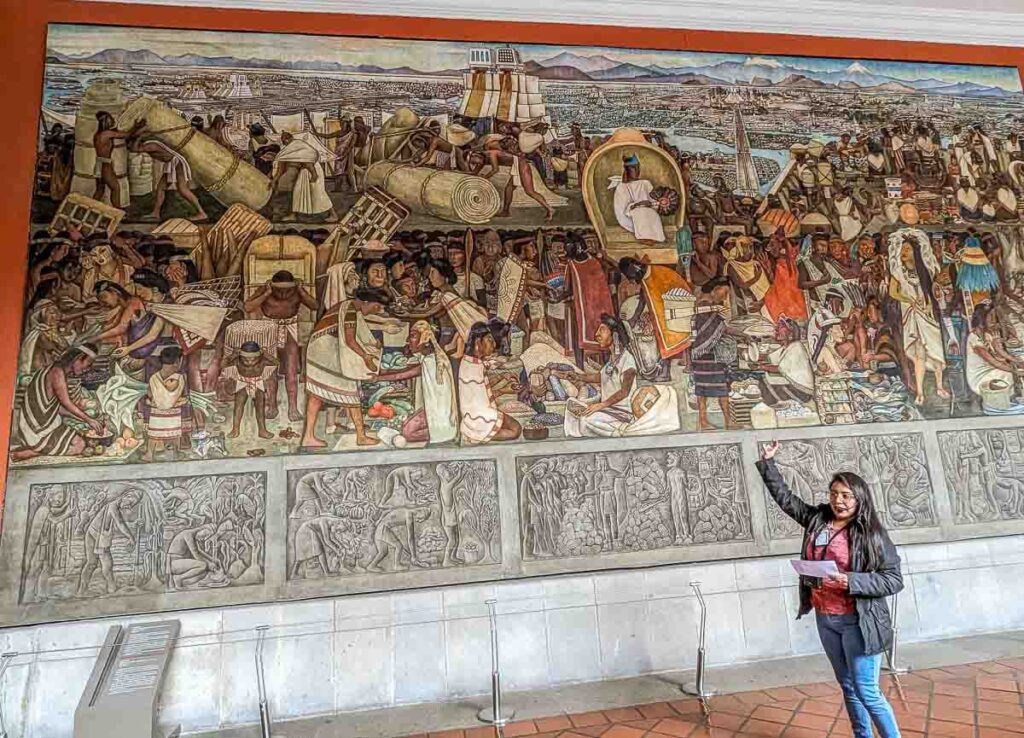
As the residence of the President of Mexico, seeing the Palacio Nacional murals requires some planning and an ID card.
To access the building which is located on the Zocalo, you must go on a guided tour which you can sign up for at this location.
Things to Know Before You Go
- Tours in English – National Palace tours in English are offered daily at 10:30 am and 3:30 pm. But it’s best to check with the office ahead of time as they do fill up. Plus, there may be additional English tours scheduled that day if there are enough people.
- Bring Identification – Since it is a government building, you are required to leave a valid ID at the desk before you begin the tour.
- Security – You will be required to go through a security checkpoint. Bags and backpacks must be left at the front desk where you leave your ID.
Keep in Mind – Access to the National Palace may be unexpectedly prohibited due to protests and other events that occur in the city center. If you happen to visit when that’s the case, there are many other points of interest to visit in downtown Mexico City.
2. Palacio de Bellas Artes
📍 Centro Histórico (Map Location)
⌚ Tuesday – Sunday, 10 am to 6 pm
💵 70 MXN, Free on Sundays for residents and Mexican nationals
Inside the Palace of Fine Arts is a permanent collection of 17 murals from the top artists of the Mexican muralism movement. The collection includes one of the most controversial Diego Rivera murals, “Man at the Crossroads.”
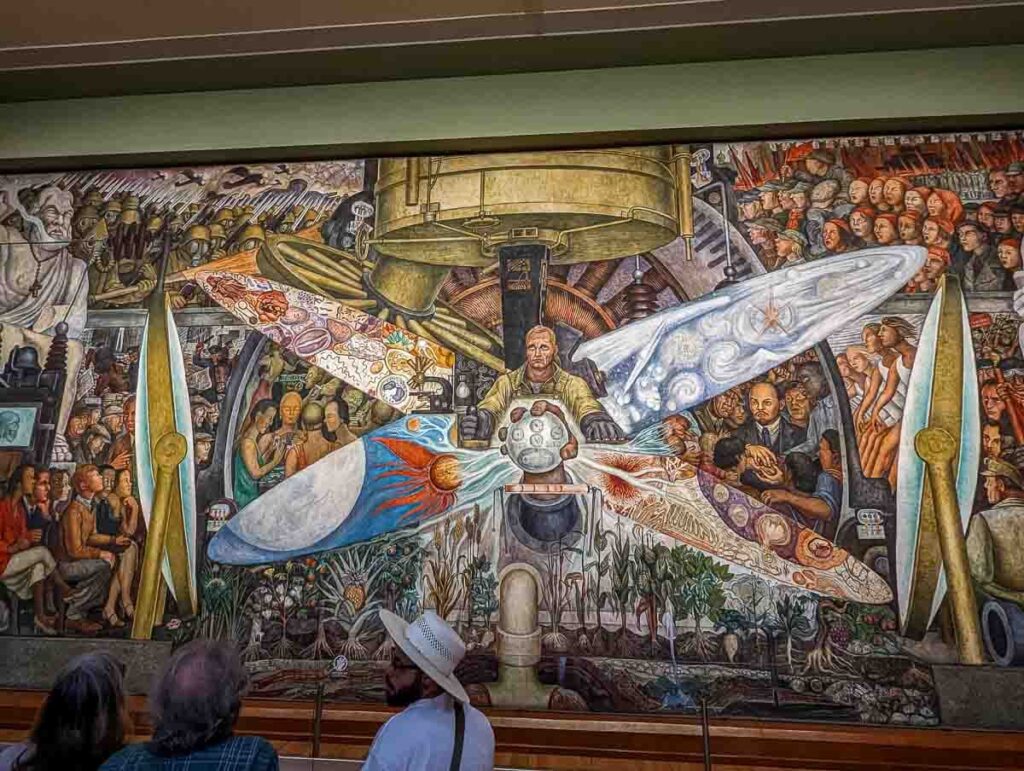
The mural captures the tension between the capitalist and communist ideologies of the early 20th century. At its center stands a worker, symbolizing the common man at the crossroads of these conflicting paths. Surrounding him are scenes depicting the advancements of science and industry, alongside the struggles and inequalities they bring.
Brief History of Man at the Crossroads
The Rockefeller family was a big fan of Rivera’s work and originally commissioned this mural for the Rockefeller Center in New York City.
Although the theme of the mural was pre-approved, it began to generate controversy in the press before it was completed for being pro-communist.
When Diego Rivera refused to remove his depiction of the communist leader, Vladimir Lenin, the director of the Rockefeller Center ordered the mural to be covered up with plaster and thus destroyed.
In anticipation, Rivera took pictures before its destruction and recreated the mural at the Palacio de Bellas Artes.
Want to visit Casa Azul? Read this guide on how to buy tickets to Frida Kahlo Museum.
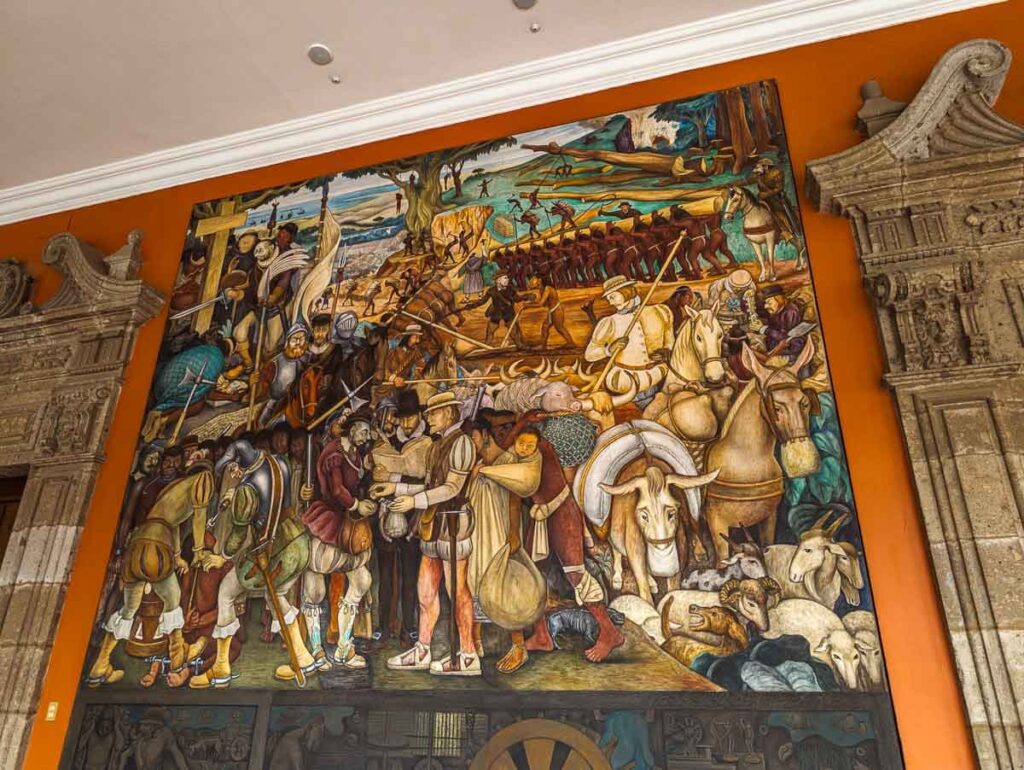
3. Secretaría de Educación Pública (SEP)
📍 Centro Histórico (Map Location)
⌚ Monday – Friday, 9 am to 6 pm
💵 Free
Update 2024: The SEP building is currently being renovated, thus these Diego Rivera murals in Mexico City are unavailable to view.
A short walk from the Zócalo, the Secretary of Public Education building houses some of the first murals in Mexico City. It is a hidden gem that offers visitors a deep dive into the work of Mexican muralists.
As you enter, the historical building transports you into a world where art and architecture blend seamlessly. As you’re guided through a series of courtyards they unfold like the pages of a Mexican art history book.
I had tried to achieve a harmony in my painting with the architecture of the building.
– Diego Rivera
Entering from the Plaza de Santo Domingo side, you’re greeted by the striking works of David Alfaro Siqueiros, one of the leaders of the movement.
As you continue, you’ll find the expansive double courtyard which houses an incredible collection of murals painted by Diego Rivera in the 1920s.
As you ascend from the ground floor to the second level, the evolution of Rivera as an artist is revealed. For Diego Rivera fans, the murals at SEP are a must see.
Curious about the technical process Diego Rivera used to create his murals? Watch the video below for details.
4. Museo Mural Diego Rivera
📍 Centro Histórico (Map Location)
⌚ Tuesday – Sunday, 10 am to 6 pm
💵 45 MXN, Free on Sundays
This museum in Mexico City is the guardian of one of the best Diego Rivera murals, Dream of a Sunday Afternoon in Alameda Central Park. The journey to the current mural’s location is as dramatic as the scenes it depicts.
This mural was commissioned for Hotel del Prado. While the mural’s theme of the nearby Alameda Park was decided upon, Rivera included a scroll with the phrase, “Dios no existe” (God does not exist).
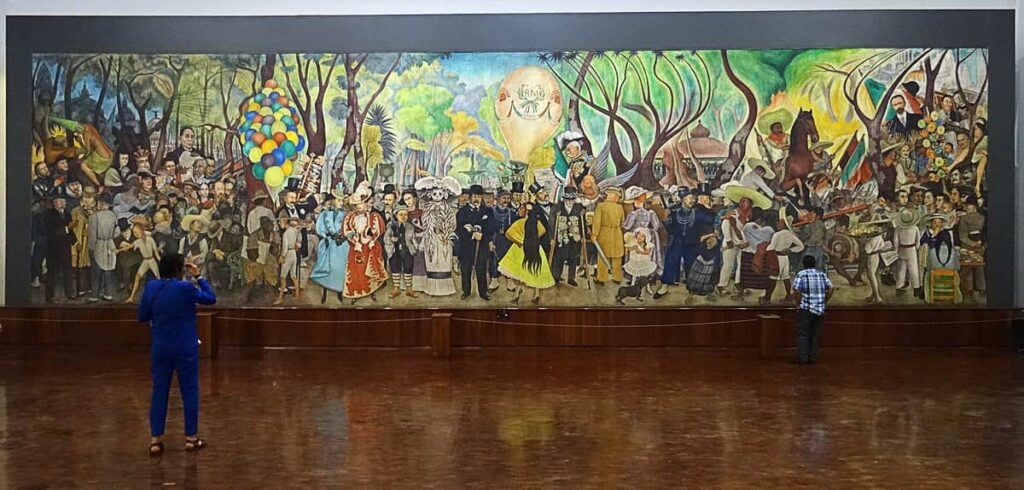
After an archbishop refused to bless the space and other controversy, the mural was covered up and rarely shown. Nearly 20 years later, the artist changed it to the title of the Ignacio Ramírez speech that began with the same phrase.
Originally painted inside the hotel restaurant, this wide mural was moved to the lobby just over a decade later. Then, during the earthquake of 1985, the hotel was practically destroyed. Its restaurant was in ruins. But amazingly the mural survived in the lobby.
In 1986, the mural was carefully moved to its current location with the help of more than 300 workers over the course of 12 hours. Afterward, the Mexico City Diego Rivera Mural Museum was built to house the work.
Symbolism in Dream of a Sunday Afternoon in Alameda Central
Sueño de una Tarde Dominical en la Alameda Central features an array of characters. In the center is La Calavera Catrina, one of the most recognizable figures of Day of the Dead celebrations in Mexico.
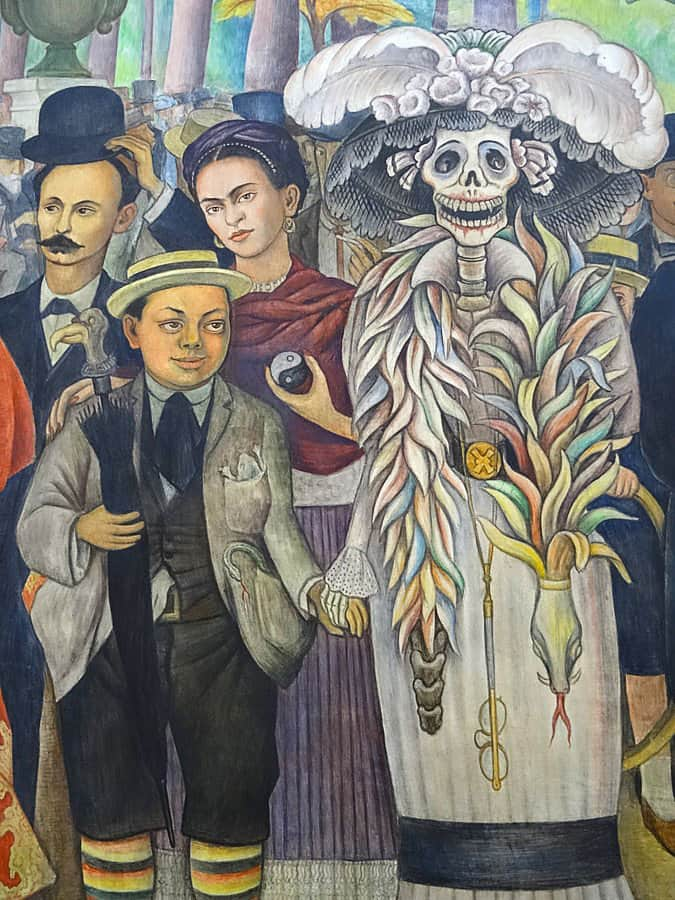
On one side she embraces the arm of the Mexican graphic artist who first envisioned her, José Guadalupe Posada. On the other she holds the hand of a 9 year old Diego Rivera who stands with the hand of Frida Kahlo on his shoulder.
On the left side, other scenes depict the colonial era with figures such as Hernán Cortés making an appearance and the beloved Benito Juarez.
On the right, Rivera illustrates the way in which the Mexican Revolution developed while portraying the mistreated lower class and the dream of justice. A child version of himself appears again, this time eating a piece of cake.
5. San Ildefonso College
📍 Centro Histórico (Map Location)
⌚ Tuesday – Sunday, 10 am to 5:30 pm
➡️ Guided Mural Visits at 11:30,12:30, and 1:30
💵 50 MXN, Free on Sundays
Built in the 16th century, San Ildefonso College is a former Jesuit school that’s been transformed into one of Mexico City’s many museums.
It is considered the cradle of Mexican muralism thanks to José Vasconcelos who as the Secretary of Public Education supported the mural works of several now famous Mexican artists.
Fun Fact – Diego Rivera and Frida Kahlo first crossed paths at San Ildefonso College when she was 16 years old. She was one of just 35 female students enrolled at the National Preparatory School.
Inside the Simón Bolívar Amphitheater is the first mural Diego Rivera painted, The Creation. Rivera painted this mural in 1922 after he returned to Mexico from Europe.
He used a technique of copal resin emulsified with beeswax and a mixture of pigments, using the hot wax as a fixative.
This mural showcases a blend of styles and ideas that would later become hallmarks of Diego Rivera’s work. They include the geometric framework of the piece, elements of Mexican nationalism, lavish curves of the human figure, and clusters of notable figures.
In addition to the murals by Diego Rivera, José Clemente Orozco, Fernando Leal, and others, this venue hosts a variety of art exhibits and events.
6. Museo del Cárcamo de Dolores
Located within the verdant expanse of El Bosque de Chapultepec, Mexico City’s largest green space, lies a hidden gem that Rivera aficionados will not want to miss.
Cárcamo de Dolores is a hydraulic building that was built in the 1950s near the Lerma River, once a water supply for CDMX. There are two Diego Rivera artworks located here, both of which celebrate the use of water throughout Mexican culture.
Outside is a mosaic sculpture that measures 100 feet across depicting the God of Rain, Tláloc laying on his back.
Inside, one of my favorite Diego Rivera murals is painted on the tunnel that leads to the water tank in the middle of the building. El agua, el origen de la vida (Water, the Origin of Life) envelopes the space, taking over all four sides and the floor of the tunnel.
Fun Fact – Before this mural was created, the paint mixture was tested to withstand the constant stream of water that flowed through the tunnel and into the tank.
The entire mural is meant to remind us how essential water is for life. A reminder that seems ever more important as Mexico City and much of the country struggles with its water supply.
After it was completed, Diego Rivera said Cárcamo de Dolores was one of the most fascinating commissions of his career.
7. Teatro de los Insurgentes
📍 Barrio San José Insurgentes (Map Location)
⌚ Ticket Office Open 10 am – 6 pm
💵 Free to View the Mural
Completed in 1953, this mural spans 150 feet (46 meters) along the entire facade of the theater located in the Insurgentes neighborhood. It was created as a tribute to the world of Mexican theater.
In the center of the unnamed mural is a mask adorned with a sun and moon. Above the mask the Mexican actor and comedian, Cantinflas, is depicted as Robin Hood distributing wealth from the rich to the poor.
Final Thoughts on Diego Rivera Murals Mexico City
Each of these mural locations offer a unique window into the soul of Mexico as seen through the eyes of one of its most famous artists.
These murals by Diego Rivera are not just art. They showcase the history, culture, and revolution of Mexico. I can only imagine what it would be like to live in CDMX at the time and witness one of these masterpieces as it was created.
Whether you’re a history buff, an art lover, or just curious about Mexico, visiting these Diego Rivera murals in Mexico City is a fun way to journey through Mexico’s vibrant history and its unyielding spirit of resilience.
FAQ About Mexico City Diego Rivera Murals
Where can I see Diego Rivera murals in Mexico City?
You can see Diego Rivera murals at various locations in Mexico City, including the Palacio Nacional, Palacio de Bellas Artes, Secretaría de Educación Pública, Museo Mural Diego Rivera, and San Ildefonso College, among others.
Where are most of Diego Rivera’s murals?
Most of Diego Rivera’s murals are located in public buildings and institutions throughout Mexico City, such as government buildings, cultural centers, and educational institutions. These murals are often commissioned works that reflect themes of Mexican history, culture, and society.
What is Diego Rivera’s most famous mural?
Diego Rivera’s most famous mural is arguably “Dream of a Sunday Afternoon in Alameda Central,” which is located in the Museo Mural Diego Rivera. This mural is renowned for its depiction of historical figures, including Rivera himself and Frida Kahlo, as well as its exploration of Mexican culture and identity.
What did Diego’s murals in Mexico often reference?
Diego Rivera’s murals in Mexico often reference themes of social justice, political activism, indigenous heritage, and the struggles of the working class. His artworks serve as powerful visual statements that advocate for social change and celebrate the diversity and resilience of Mexican people.
What is the significance of Diego Rivera painting the Palacio Nacional in Mexico City?
As the seat of the federal government, the Palacio Nacional was an important landmark for Rivera to depict the story of the Mexican people. His murals helped educate and unite the public by depicting scenes from Mexico’s pre-Hispanic past, the Spanish conquest, colonial rule, and the Mexican Revolution.

